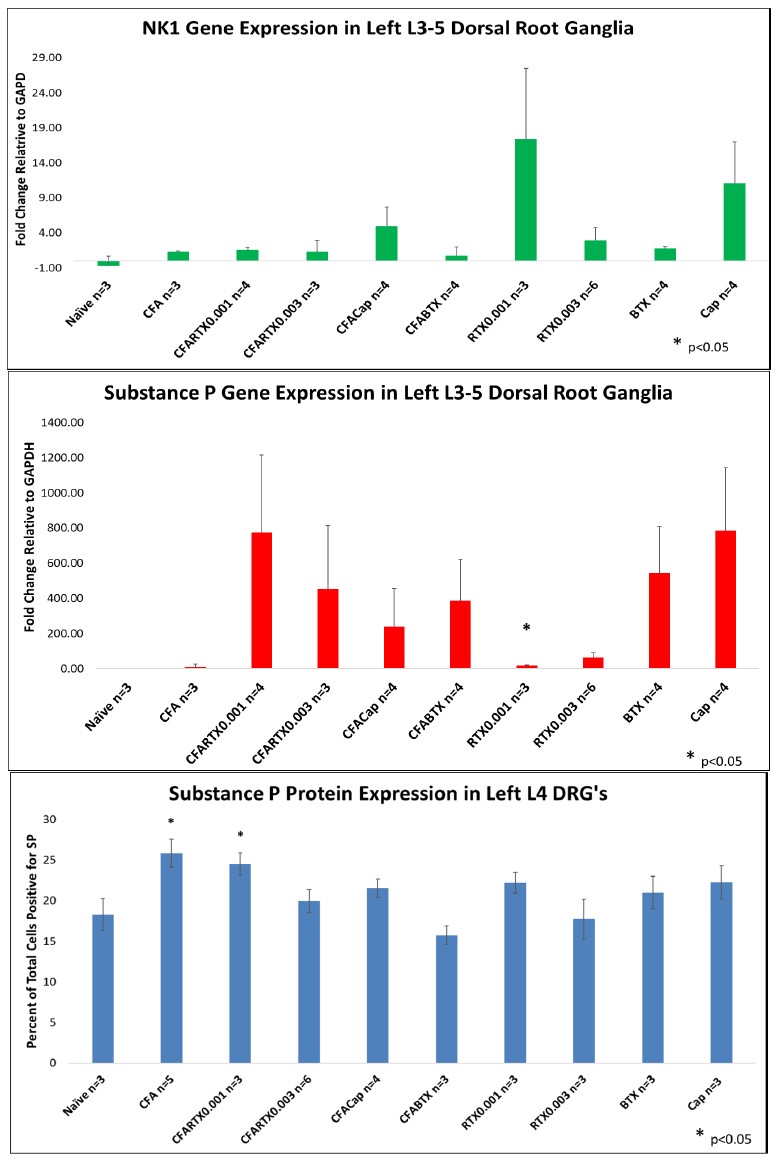Session Information
Date: Saturday, November 7, 2020
Title: RA – Animal Models Poster
Session Type: Poster Session B
Session Time: 9:00AM-11:00AM
Background/Purpose: Neurotoxins are increasingly being proposed as analgesics for arthritis pain. Phase II and III clinical trials have shown efficacy but with potential toxicities such as rapidly progressive osteoarthritis that may be neurally mediated. We have shown efficacy of intra-articular (IA) onabotulinumtoxinA (BTX) and the vanilloids capsaicin (CAP) and resiniferatoxin (RTX) in monoarthritis in mice. To better understand the effect of these toxins on the sensory nervous system we examined their effect on the expression of substance P (SP) and neurokinin 1 receptor (NK1) in the dorsal root ganglion (DRG).
Methods: C57/Bl6 male mice received intra-articular (IA) Complete Freund’s Adjuvant (CFA) to produce chronic inflammatory monoarthritis. IA therapies were given at appropriate intervals before examination and DRG harvest. Tissue samples were obtained after arthritis induction at 12 weeks of age from mouse dorsal root ganglia (DRG) and were subjected to immunohistochemistry and real-time reverse transcription polymerase chain reaction (RT-PCR). Neurotransmitter substance P (SP) protein expression was measured as percent of DRG neurons expressing SP. Both SP and receptor neurokinin-1 (NK1) gene expression were quantified using RT-PCR and expressed as a fold change relative to GAPDH values.
Results: CFA induction resulted in a significant increase in % SP protein expressing cells in DRG’s but gene expression of SP and NK1 were not significantly changed from naïve. Neither vanilloids nor BTX had any effect on SP protein expression in nonarthritic animals. Only low dose RTX significantly increased SP gene expression in nonarthritic animals but had no effect onNK1 gene expression . High dose RTX, CAP and BTX all normalized % SP protein expressing cells in the DRG of arthritic animals but NK1 and SP gene expression was not significantly different from naïve. Interestingly, SP gene expression was more variable in all treated arthritic animals and in nonarthritic animals treated with BTX and CAP. NK1 gene expression in low dose RTX and CAP treated non arthritic animals was also more variable than in other groups. In general, BTX and CAP produced an increase in SP gene expression in nonarthritic animals but this was not significant.
Conclusion: Alterations in SP protein expression in the DRG of mice with chronic monoarthritis does not appear to be related to increased gene expression of either SP or NK1. Although the mechanism of action of BTX and vanilloids is hypothesized to be quite different, there does not appear to be a consistent effect of impaired neurotransmitter release (BTX) or enhanced release (vanilloids) on SP or NK1 gene expression. Although numbers were small in this experiment, variability may be due to inherent differences in the animals’ pain perception, pain behavior and response to therapy. Further studies to correlate pain behavior to SP and NK1 expression and to TRPV1 expression would be informative.
 Substance P and NK 1 Receptor Gene and Protein Expression in the DRG of Mice with Inflammatory Monoarthritis: Effect of Neurotoxin Treatment.
Substance P and NK 1 Receptor Gene and Protein Expression in the DRG of Mice with Inflammatory Monoarthritis: Effect of Neurotoxin Treatment.
To cite this abstract in AMA style:
Krug H, Blanshan N, Dorman C, Frizelle S. Effect of IA OnabotulinumtoxinA and Vanilloids on Substance P and Neurokinin 1 Receptor Expression in the Dorsal Root Ganglia of Mice with Monoarthritis [abstract]. Arthritis Rheumatol. 2020; 72 (suppl 10). https://acrabstracts.org/abstract/effect-of-ia-onabotulinumtoxina-and-vanilloids-on-substance-p-and-neurokinin-1-receptor-expression-in-the-dorsal-root-ganglia-of-mice-with-monoarthritis/. Accessed .« Back to ACR Convergence 2020
ACR Meeting Abstracts - https://acrabstracts.org/abstract/effect-of-ia-onabotulinumtoxina-and-vanilloids-on-substance-p-and-neurokinin-1-receptor-expression-in-the-dorsal-root-ganglia-of-mice-with-monoarthritis/
